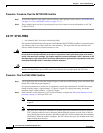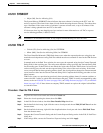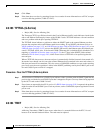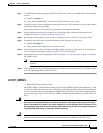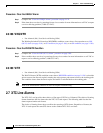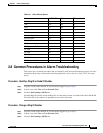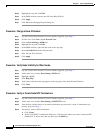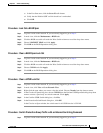
2-120
Cisco ONS 15327 Troubleshooting Guide, R3.4
March 2004
Chapter 2 Alarm Troubleshooting
Alarm Procedures
Step 8 Click Close.
Step 9 If the alarm does not clear, log onto http://www.cisco.com/tac for more information or call TAC to report
a service-affecting problem (1-800-553-2447).
2.6.183 TPTFAIL (G-Series)
• Major (MJ), Service Affecting (SA)
The Transport (TPT) Layer Failure alarm for the G-series Ethernet (traffic) cards indicates a break in the
end-to-end Ethernet link integrity feature of the G1000-2 cards. TPTFAIL indicates a far-end condition
and not a problem with the port reporting TPTFAIL.
The TPTFAIL alarm indicates a problem on either the SONET path or the remote Ethernet port that
prevents the complete end-to-end Ethernet path from working. If any SONET path alarms such as an
AIS-P condition (see page 2-17), an LOP-P alarm (see page 2-80), a PDI-P alarm (see page 2-93), or an
UNEQ-P alarm (see page 2-122) exist on the SONET path used by the Ethernet port, the affected port
causes a TPTFAIL alarm. Also, if the far-end G1000-2 Ethernet port is administratively disabled or it is
reporting a CARLOSS (G Series) alarm (see page 2-33), the C2 byte in the SONET path overhead
indicates a PDI-P alarm (see page 2-93) which in turn causes a TPTFAIL to be reported against the
near-end port.
When a TPTFAIL alarm occurs, the near-end port is automatically disabled (transmit laser turned off).
In turn the laser shutoff can also cause the external Ethernet device attached at the near end to detect a
link down and turn off its transmitter. This also causes a CARLOSS condition to occur on the reporting
port. In all cases the source problem is either in the SONET path being used by the G1000-2 port or the
far- end G1000-2 port to which it is mapped.
Procedure: Clear the TPTFAIL (G-Series) Alarm
Step 1 An occurrence of TPTFAIL on a G1000-2 port indicates either a problem with the SONET path that the
port is using or with the far-end G1000-2 port that is mapped to the port. Clear any alarms being reported
by the OC-N card on the G1000-2 circuit.
Step 2 If no alarms are reported by the OC-N card, or if a PDI-P alarm (see page 2-93) is reported, the problem
might be on the far-end G1000-2 port. Clear any alarms, such as CARLOSS, reported against the far-end
port or card.
Step 3 If the alarm does not clear, log onto http://www.cisco.com/tac for more information or call TAC to report
a service-affecting problem (1-800-553-2447).
2.6.184 TRMT
• Major (MJ), Service Affecting (SA)
A Missing Transmitter (TRMT) alarm occurs when there is a transmit failure on the XTC-14 card
because of an internal hardware failure. The card must be replaced.







